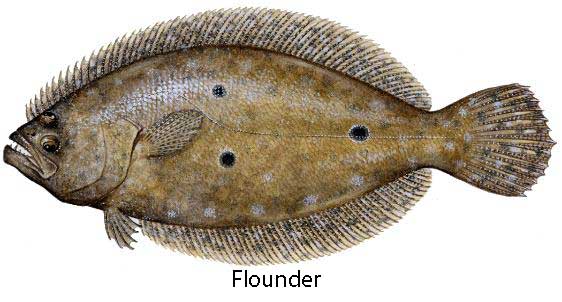
FLOUNDER

Paralichthys lethostigma
English: Flounder, southern flounder, gray sole.
Spanish: Lenguado, rodaballo y platija .
The Southern Flounder is a popular sports fish and is the largest and most commercially valuable flounder in the western north Atlantic ocean and Gulf of Mexico.Its range is North Carolina to the Yucatan peninsula.
All flatfishes, including the southern flounder, are compressed laterally and spend most of their life lying and swimming along the bottom on their side. In the case of southern flounder, the left side is always the "up" side; in other species, the opposite is true. Small flounder grow rapidly and may reach 12 inches in length by the end of their first year. Males seldom exceed 12 inches, but females grow larger than males and often reach a length of 25 inches.
Flounder are taken by rod and reel or by gig. When fishing with rod and reel, light tackle offers both the greatest sport and best chance for catching flounder. Both artificial lures and natural bait can be used. Over barren bottoms, leaded plastic worms (worm jigs) are often very effective. In heavily vegetated areas, shallow-running spoons are best.
Flounder prefer live to dead bait. Live shrimp retrieved slowly along the bottom often produce excellent results. Killifish (referred to locally as mud minnows) fished in a similar fashion, is good bait. These fish can often be taken in large numbers with the cast or minnow seine.
Although many are taken by rod and reel, "floundering" or gigging offers the best challenge for this species. The flounder is vulnerable to this technique because it often enters the shallows at night to feed. Both the skills of the angler and the hunter are called for here.
Lanterns are used in searching for flounder and gigs ranging from single-pronged to modified hay forks are used to spear the fish. The anglers wade quietly along the shallows looking for flounder. Once the flounder is within the light from the lantern, normally it will not move, affording the fisher a chance to "gig" the fish. Although this sounds like a sure-fire method, many fish are missed because they go undetected until they swim away or because of inaccurate gigging by an overanxious angler.
The more sophisticated flounder fisher may mount his lanterns (or battery-powered lamps) on the front of a flat-bottomed skiff. The skiff is then poled through the water in search of fish or is pushed by a small air motor. Floundering from a boat is much easier than wading. It allows the angler to cover more area and search bottoms that are too soft for wading.